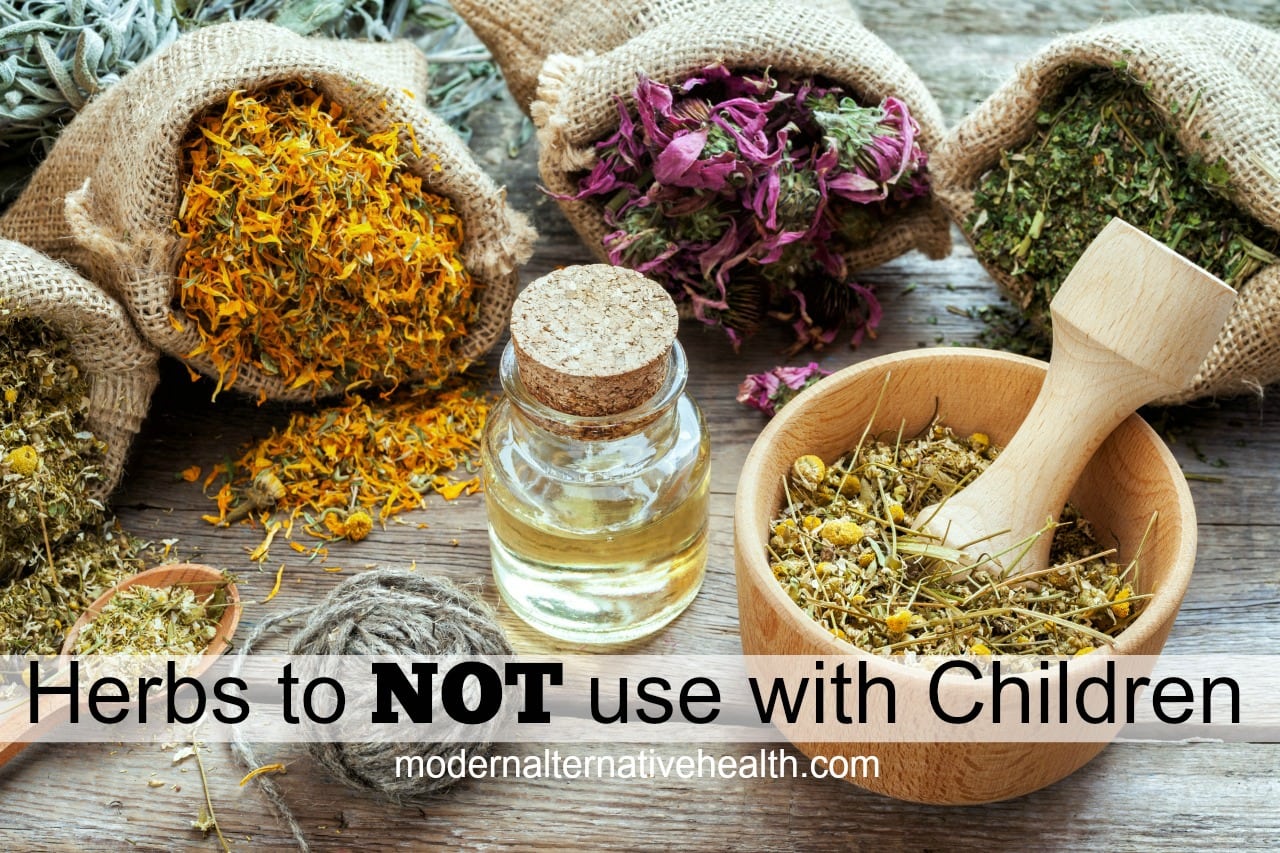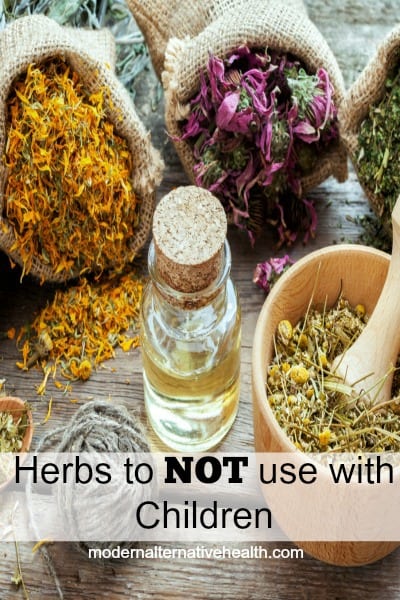
By Heather Harris, contributing writer
When my kids got sick, I used to call the doctor and get a prescription.
Easy enough, and I felt I was doing the right thing. As I got more involved in natural health, I wondered if there was a way to help their colds and coughs at home, with more natural methods. I started studying herbs and found that there WERE, in fact so many ways to help them without always doing to the doctor.
Many parents are now reaching for the all natural herbs and essential oils when their kids get sick.
Natural medicines like herbs have been around for centuries, so they have to be safe, right? Well, not always. There are some herbs that you should NOT use with your children. Surprised? So was I, at first. But, when you start looking at pharmacological actions of each herb, you’ll better understand that some are just not right for their growing bodies. Let’s look at some of them.
Herbs to NOT Use With Children
Herbs to Not Use Due to Over-Harvesting
Goldenseal (Hydrastis canadensis)
- This has been used as a natural antibiotic, especially for respiratory issues. However, due to it’s being overharvested, it is now endangered. Herbalists are now turning to the more sustainable Oregon Grape Root, which has the same pharmacological actions. [source]
- Slippery Elm (Ulmus rubra)
- This is often used as a sore throat soother, but is now on the endangered list. For a more sustainable option, you can choose Marshmallow (Althea officinalis), or Mullein (Verbascum thapsus) which have the same actions. [source]
Herbs to Usually Avoid with Children
Uva Ursi
(Arctostaphylos uva-ursi) is often used as a diuretic and a support for the kidneys. The literature supports the use of Uva Ursi for relief of pain associated with kidney stones, as it causes an increase in urine output and smaller stones will often run out. This is not to be given to children under the age of 12, as their kidneys may not be fully matured and able to handle this powerful herb.
Cascara sagreda (Rhamnus purshiana)
Most often used for relief of constipation short term. The side effects of this can be loss of electrolytes, making it often unsuitable for children under the age of 10. A better alternative would be fresh fruits and vegetables and plenty of fiber containing foods and water. [source]
Black Cohosh (Cimifuga racemosa)
This is most often used for its antispasmodic and sedative benefits. It also has a steep history of being used for female ailments, mainly for balancing hormones. Due to its estrogen like actions, it is often unsuitable for children. [source]
Poke Root (Phytolacca decandra)-
This is often used to assist in treating goiters, as well as as skin conditions such as boils, ringworm, and scabies. Due to its high potency, and being fatal in large amounts, this is often unsuitable for children and should ONLY be used under careful guidance. [source]
Mistletoe (Viscum album)
This herb is highly toxic. Its fresh berries and leaves can be lethal. Under proper guidance, it can be safe, but should NEVER be attempted to be used by the home health manager. [source]
Herbs to Only Use Externally
Arnica (Arnica Montana)
This refers to the whole dried flower heads of the plant, as well as the extracts made from these parts. it is suitable for bruises, insect bites and external injuries. It should not be taken internally, nor should it be used externally for extended periods of time. Take a break from using it after 2 weeks.
Note: Homeopathic Arnica, that you can buy over the counter is NOT the same as herbal Arnica. The homeopathic version has been strongy diluted in accord with homeopathic principles, and is safe to take internally.
Comfrey (Symphytum officinale)
This is commonly used for bruises, sprains and broken bones. It should only be used externally, and only on unbroken skin. This is because broken skin has more direct access to the blood stream and the alkaloids are hepatotoxic.
Herbs That Are Commonly Allergenic
Chamomile (Matricaria recutita)
Those with allergies to ragweed should avoid using chamomile.
Echinacea Root (Echinacea angustifolia)
As an immune system stimulant, this is unsuitable for those with an autoimmune disorder.

Herbs can be a great source of natural healing.
However, a little common sense and knowledge of each herb and its pharmacological actions will go a long way toward keeping you and your children healthy and safe.
What herbs do you use when your kids are sick? Did any on this list of herbs to not use with children surprise you?


My understanding, as far as comfrey is concerned, is that the ROOT is what’s the problem, not the leaves.
I was surprised to learn about Chamomile as an allergenic . I used it as a soothing goodnight tea for my oldest son as a baby and toddler. Thank goodness he never was an allergenic. I will certainly remember your info. Thank you.
I am glad that it helped! Many people many not know about Chamomile being in the same family as ragweed…I certainly didn’t before I started school for herbalism.
hmmmm …I thought mistletoe was poisonous no matter what age lol.
I have terrible environmental allergies (though getting better!) and if I have chamomile my mouth itches, throat and nasal passages swell, and stomach gets irritated. I can get headaches or very tired, also. I stopped using it in anything for my children because they, too, have allergies. So beware, the reactions can be fairly severe from a ‘soothing’ herb that is found in an enormous number of teas, lotions, and supplements.
i disagree with the majority of the information.. but there is a wisdom to using herbs and should be under consult of an herbalist to understand how to use the herb. Comfrey isn’t an issue .. but you give to a child per their weight and issue.. there are other herbs gentler in use. chamomile .. issue when it has been sprayed with herbacide or any other cide they put on what grows in america…
What a great article and website. I am just starting learning about herbs and will mark ths website down to refer too. A ND shared your website w me when I asked about using herbs around kids as I didn’t know where to look for the info. I’m also looking for info on using herbs around cats (not on them).
Belladonna. It’s toxic and was used in medieval times as a poison,but if you look in homeopathic teething medicines you will see belladonna listed. That’s insane!